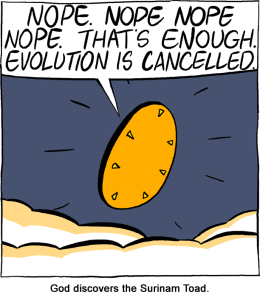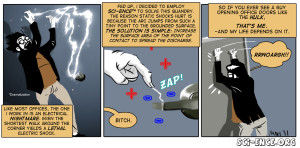
There are nearly endless ways in which scientists can engage in outreach. In a series of blog posts we will explore a handful of outreach outlets, and share stories from people who use these outreach tools. First up, COMICS!
Comics as a tool for science outreach
We spoke with Maki Naro and Zach Weinersmith to learn about how comics can be used as a tool for science outreach. Maki does a science comic called Sci-ence, and Zach does a comic called Saturday Morning Breakfast Cereal (SMBC) that frequently covers science topics. We asked the same set of questions to each creator, and share their answers below.

Interview with Maki Naro of Sci-ence
1. Why did you choose to do science outreach via comics?
Comics always seemed perfect to me because not only is there the important visual element, but also the oft-missed narrative element. Science is all about stories. Just like a good narrative, the concepts and ideas expressed have to follow in a logical manner, and being able to see that narrative unfold is important for any reader. Also, comics are really fun 🙂
2. Along with you, who are some key science comics/science art folks that scientists new to outreach should know about?
Oh wow, I could probably write for hours and still miss somebody important. While I’m on a roll with the narrative thing, my mind immediately goes to works like Logicomix or Ottaviani & Myrick’s Feynman book. For somebody just starting out, a comic like mine can be understandably daunting to dive in to, and it’s something I’m constantly working on. But comic books about scientists put the personalities and the love of science first. You get to understand why they were so passionate about the ideas, while also learning a thing or two. They’re a great segue between graphic novels and straight science comics.
3. How would a scientist get started with science comics?
Oops, I think I accidentally segued into this one. Do you mean start using them? Drawing them? If it’s the former, the key is finding somebody who you really mesh with, and it doesn’t hurt if they’re enthusiastic about your field, either. As far as drawing goes: Draw every day. I don’t believe in talent. It’s no mystery that people with “talent” also happen to fill their lives with the thing that they are talented in. Drawing is frustrating and difficult, and then you have to write, too! So comics can be daunting, but hard work is generally thusly rewarded.
4. Any other things that a scientist interested in science comics should know?
Definitely take the time to really look around. The first big mistake I made when I started Sci-ence was thinking that there was nothing out there. I remember thinking, “Well there’s XKCD, SMBC, and…that’s it. Ripe for plunder!” But to this day I’m still discovering awesome science content in virtually every field—and it’s awesome. Heck, just today I found a Russian blog that featured a bunch of great science comics. I wish I could read Cyrillic…
Thanks, Maki!
Interview with Zach Weinersmith of SMBC
[youtube]http://youtu.be/eixJB3eNyT0[/youtube]

